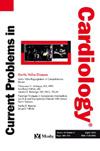沙比利-缬沙坦治疗癌症引起的心力衰竭:功能和血流动力学参数的系统回顾和荟萃分析。
IF 3.3
3区 医学
Q2 CARDIAC & CARDIOVASCULAR SYSTEMS
引用次数: 0
摘要
背景:癌症治疗诱导的心脏毒性(CTRCD),以心力衰竭伴射血分数降低(HFrEF)的形式,正日益被认识到。然而,sacubitril/缬沙坦(S/V)治疗CTRCD继发HFrEF的潜在益处尚不清楚。目的:我们进行了一项系统回顾和荟萃分析,以评估S/V在预防心脏毒性方面的有效性。方法:我们检索PubMed、Embase和Cochrane数据库,以评估CTRCD导致的HFrEF患者的S/V,并报告以下结果:(1)NYHA分级;(2) NT-ProBNP和(3)超声心动图测量,特别是左室射血分数(LVEF)、整体纵向应变(GLS)和E/ E’比。采用RStudio软件进行统计分析。采用I²统计量评估异质性。结果:我们纳入了来自6项研究的257例患者。所有患者均接受S/V。患者平均年龄为63±8岁,85%的患者患有乳腺癌。基线时平均LVEF为34±7%。与基线相比,S/V显著提高了NYHA等级(MD -0.7;95% CI -1.2 ~ -0.3;结论:在CTRCD致HFrEF患者中,S/V可显著改善左室收缩和舒张功能的临床和超声心动图参数。本文章由计算机程序翻译,如有差异,请以英文原文为准。

Sacubitril-valsartan in Cancer therapy-induced heart failure: A systematic review and meta-analysis of functional and hemodynamic parameters
Background
Cancer therapy-induced cardiotoxicity (CTRCD), in the form of heart failure with reduced ejection fraction (HFrEF), is being increasingly recognized. However, the potential benefits of sacubitril/valsartan (S/V) in managing HFrEF secondary to CTRCD remain unclear.
Objective
We performed a systematic review and meta-analysis to assess the effectiveness of S/V in preventing cardiotoxicity.
Methods
We searched PubMed, Embase, and Cochrane databases for studies evaluating S/V in patients with HFrEF due to CTRCD and reporting the following outcomes: (1) NYHA class; (2) NT-ProBNP and (3) echocardiographic measurements, specifically left ventricular ejection fraction (LVEF), global longitudinal strain (GLS) and E/e' ratio. Statistical analyses were performed using RStudio software. Heterogeneity was assessed using I² statistics.
Results
We included 257 patients from six studies. All patients received S/V. The mean patient age was 63 ± 8 years, and 85 % of patients had breast cancer. The mean LVEF was 34±7 % at baseline. S/V significantly improved NYHA class compared to baseline (MD -0.7; 95 % CI -1.2 to -0.3; p < 0.01), NT-proBNP (MD -985.1 pg/mL; 95 % CI -1231.3 to -739.1; p < 0.01), GLS (MD -2.5 %; 95 % CI -3.6 to -1.4; p < 0.01;), and E/e’ (MD -1.99; 95 % CI 3.7 to -0.1; p = 0.03). LVEF (MD 7.3 %; 95 % CI 5.4 to 9.2; p < 0.01) with S/V treatment relative to baseline.
Conclusion
In patients with HFrEF due to CTRCD, S/V significantly improved the clinical and echocardiographic parameters of left ventricular systolic and diastolic functions.
求助全文
通过发布文献求助,成功后即可免费获取论文全文。
去求助
来源期刊

Current Problems in Cardiology
医学-心血管系统
CiteScore
4.80
自引率
2.40%
发文量
392
审稿时长
6 days
期刊介绍:
Under the editorial leadership of noted cardiologist Dr. Hector O. Ventura, Current Problems in Cardiology provides focused, comprehensive coverage of important clinical topics in cardiology. Each monthly issues, addresses a selected clinical problem or condition, including pathophysiology, invasive and noninvasive diagnosis, drug therapy, surgical management, and rehabilitation; or explores the clinical applications of a diagnostic modality or a particular category of drugs. Critical commentary from the distinguished editorial board accompanies each monograph, providing readers with additional insights. An extensive bibliography in each issue saves hours of library research.
 求助内容:
求助内容: 应助结果提醒方式:
应助结果提醒方式:


